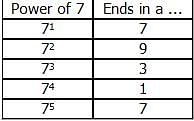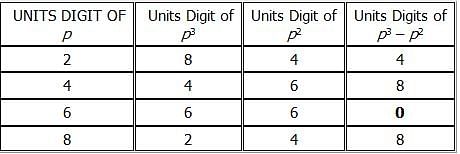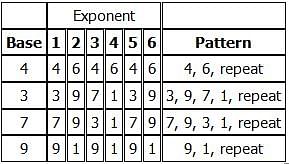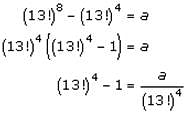GMAT Exam > GMAT Tests > Quantitative for GMAT > Test: Unit Digits, Factorial Powers - GMAT MCQ
Test: Unit Digits, Factorial Powers - GMAT MCQ
Test Description
10 Questions MCQ Test Quantitative for GMAT - Test: Unit Digits, Factorial Powers
Test: Unit Digits, Factorial Powers for GMAT 2024 is part of Quantitative for GMAT preparation. The Test: Unit Digits, Factorial Powers questions and answers have been
prepared according to the GMAT exam syllabus.The Test: Unit Digits, Factorial Powers MCQs are made for GMAT 2024 Exam. Find important
definitions, questions, notes, meanings, examples, exercises, MCQs and online tests for Test: Unit Digits, Factorial Powers below.
Solutions of Test: Unit Digits, Factorial Powers questions in English are available as part of our Quantitative for GMAT for GMAT & Test: Unit Digits, Factorial Powers solutions in
Hindi for Quantitative for GMAT course. Download more important topics, notes, lectures and mock
test series for GMAT Exam by signing up for free. Attempt Test: Unit Digits, Factorial Powers | 10 questions in 20 minutes | Mock test for GMAT preparation | Free important questions MCQ to study Quantitative for GMAT for GMAT Exam | Download free PDF with solutions
Detailed Solution for Test: Unit Digits, Factorial Powers - Question 1
Test: Unit Digits, Factorial Powers - Question 2
11+22+33+...+1010 is divided by 5. What is the remainder?
Detailed Solution for Test: Unit Digits, Factorial Powers - Question 2
| 1 Crore+ students have signed up on EduRev. Have you? Download the App |
Test: Unit Digits, Factorial Powers - Question 3
Given that p is a positive even integer with a positive units digit, if the units digit of p3 minus the units digit of p2 is equal to 0, what is the units digit of p + 3?
Detailed Solution for Test: Unit Digits, Factorial Powers - Question 3
Test: Unit Digits, Factorial Powers - Question 4
If x is a positive integer, what is the units digit of (24)(2x + 1)(33)(x + 1)(17)(x + 2)(9)(2x)?
Detailed Solution for Test: Unit Digits, Factorial Powers - Question 4
Test: Unit Digits, Factorial Powers - Question 5
If a and b are positive integers and x = 4a and y = 9b, which of the following is a possible units digit of xy?
Detailed Solution for Test: Unit Digits, Factorial Powers - Question 5
Test: Unit Digits, Factorial Powers - Question 6
If x = 321 and y = 655, what is the remainder when xy is divided by 10?
Detailed Solution for Test: Unit Digits, Factorial Powers - Question 6
Test: Unit Digits, Factorial Powers - Question 7
If x is a positive integer, what is the remainder when 712x+3 + 3 is divided by 5?
Detailed Solution for Test: Unit Digits, Factorial Powers - Question 7
Test: Unit Digits, Factorial Powers - Question 8
What is the units digit of (71)5(46)3(103)4 + (57)(1088)3 ?
Detailed Solution for Test: Unit Digits, Factorial Powers - Question 8
Detailed Solution for Test: Unit Digits, Factorial Powers - Question 9
Detailed Solution for Test: Unit Digits, Factorial Powers - Question 10
|
115 videos|106 docs|113 tests
|
Information about Test: Unit Digits, Factorial Powers Page
In this test you can find the Exam questions for Test: Unit Digits, Factorial Powers solved & explained in the simplest way possible.
Besides giving Questions and answers for Test: Unit Digits, Factorial Powers, EduRev gives you an ample number of Online tests for practice
|
115 videos|106 docs|113 tests
|
Download as PDF




 Only when the units digit of p is 6, is the units digit of p3 – p2 equal to 0.
Only when the units digit of p is 6, is the units digit of p3 – p2 equal to 0.

 , what is the units digit of
, what is the units digit of 



 is 9. The correct answer is E.
is 9. The correct answer is E.
















